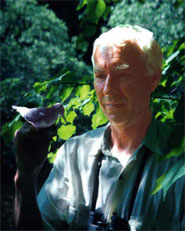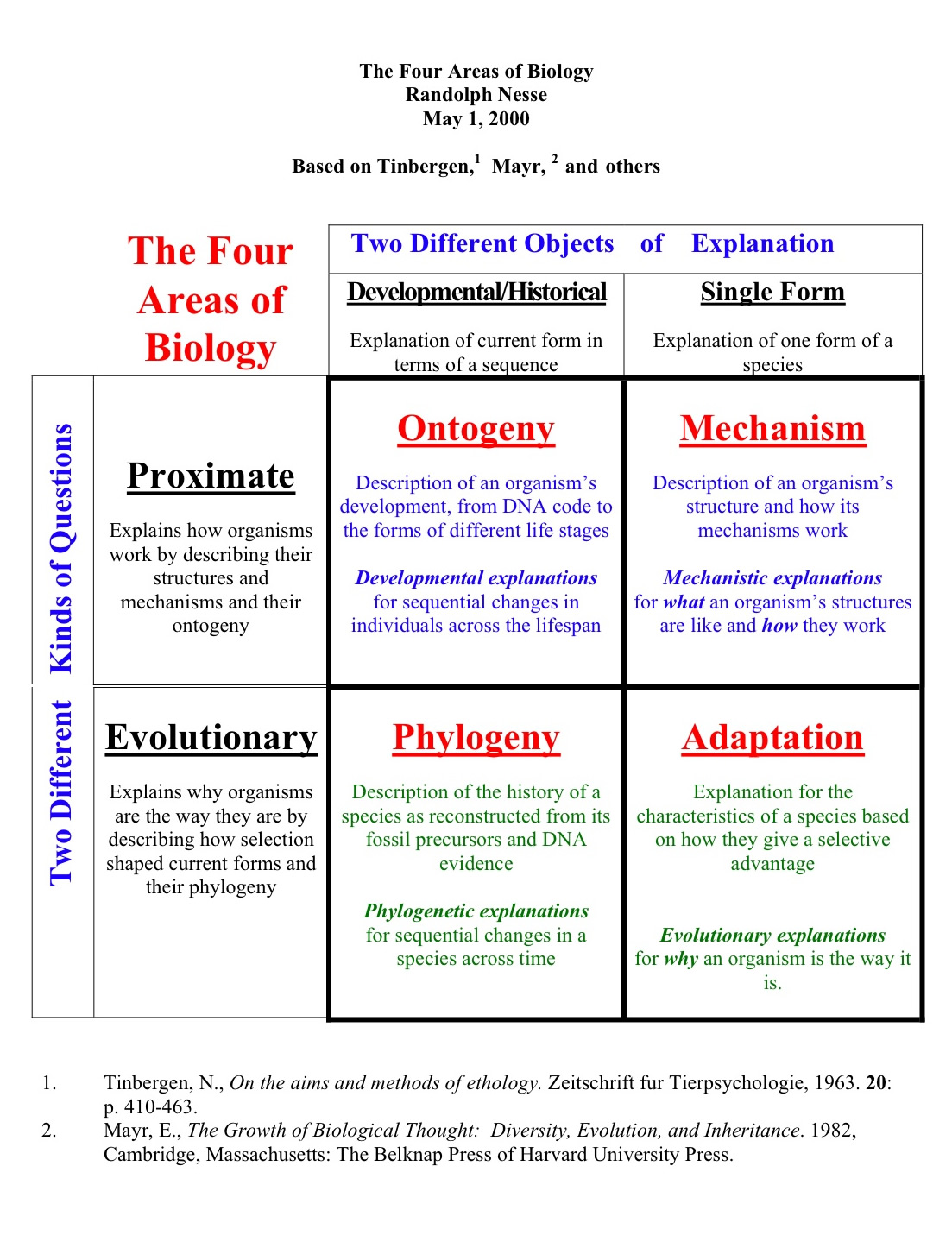Animal Behavior
Biology 342 Fall 08
Professor: Suzy Renn
Week 2 - Sept. 9th
The Evolution of Behavior (Discussion Question Day)
Answer 2 of the following 4 questions. (download
handout)
Type the answers. Bring them to class.
Be prepared to discuss and amend
your answers.
- Tinbergen repeatedly breaks categories down using dichotomies. Make a list (or better, attempt a graphical representation) of the many divisions discussed by Tinbergen. Indicate which of these dichotomies would be objectionable to Thiery and what his reasoning would be.
- Describe the scientific field to which each of Tinbergens 4 types of questions are most closely related.
- In the section on “Survival Value”, Tinbergen laments the fact that there is often a general lack of interest in studying the problem of survival value. Why was there a lack of interest in studying the problem of survival value? Does this lack of interest persist? If we were to do away with dichotomy between ultimate and proximate, how would that influence the interest, or approach to studying the problem of survival value?
- Thiery throws in a lot of names and terms that may not be familiar to all students. Prepare a few statements about, Mayr, D'arcy Thomspon, Baker, Weismann, Gould and Lewontin, Cope's rule, Arisotle's final causes, epigenetic, atomistic, phylogenetic inertia, entrenchment, any other terms that caused you to stumble.
 Every biologist should read a bit of Darwin. While Tinbergen, Lorenz,
and vonFrisch are often credited with founding the field of animal behavior,
it is really a much older field. In class we will talk about some of
the scientists who worked between the time of Darwin and the founding
of the field of Ethology, which (in my opinion) is only a small portion
of what can be considered "animal behavior".
Every biologist should read a bit of Darwin. While Tinbergen, Lorenz,
and vonFrisch are often credited with founding the field of animal behavior,
it is really a much older field. In class we will talk about some of
the scientists who worked between the time of Darwin and the founding
of the field of Ethology, which (in my opinion) is only a small portion
of what can be considered "animal behavior".
Tinbergen's 1963 paper represents a seminal contribution to Behavior, as it formulates a method for studying animal behavior. This method still forms the basis for most courses on animal behavior. These issues are central to developing a philosophical approach to animal behavior. The ethological approach had a strong Darwinian tradition underlying its development. Much of the work in ethology was aimed at understanding the ultimate evolutionary reasons for behavior. Tinbergen listed four areas of inquiry that could be used to understand issues of animal behavior. They can be constructed as two dichotomous divisions (see below). However, not all researchers approve of such dichotomies.
READ:
Chapter 1 in Essential Animal Behavior by G. Scott
Tinbergen
1963 On aims and methods of Ethology Zeitschrift fur Tiepsychology
20:410-33.
(reprinted Animal Biology, Vol. 55, No. 4, pp. 297-321 2005)
also available in Foundations of Animal Behavior.
Thiery B. (2005) Integrateing proximate and ultimate causation: Just
one more go! Current Science 89:1180-1183.
Darwin C. (1872) On
the origin of Species chapter VIII
also found in Foundations of Animal Behavior.
Week 2 - Sept. 11th
Sexuality and Sexual Selection
Entire courses are taught on Sexual Selection so it would be impossible to cover the topic thoroughly in one day. We will pay special attention to this theory as it would apply to behavior. Undoubtedly, sexual selection affects everything from morphology to the evolution of sex chromosomes, and even sex determination systems.
Charles Darwin distinguished sexual selection as variance in the number of mates.
"Sexual selection depends on the success of certain individuals
over others of the same sex, in relation to the propagation of the
species; while natural selection depends on the success of both
sexes, at all ages, in relation to the general conditions of life. "
—Charles Darwin, 1871
Sexual selection takes two major forms:
intrasexual selection (most
commonly seen as 'male–male competition') in which members of the
less limited sex (typically males) compete aggressively for access to
the limiting sex (typically females),
&
intersexual selection (also
known as 'mate choice', most commonly 'female choice') in which males
compete with each other to be most attractive to females. As we will see later
in the semester, these roles are reversed for some species. For today,
we will consider cases in which Sexual Selection and Natural Selection
may act in opposing directions.
READ:
Crews D. (1994) Animal Sexuality. Scientific
American v?:107-114.
Chapter 5 in Essential Animal Behavior by G. Scott
Andersson M. & Simmons,
L.W. (2006) Sexual selection and mate choice.
Trends in Ecology and Evolution 21:296-302.
Clutton-Brock T.
(2008) Sexual Selection in Males and Females. Science 318:1182-1185.

For futher reading, I highly recommend the 1994 book by Anderson, Sexual Selection. This book is considered to be the best reference in the field and includes many examples that include animal behavior.
For a different view read:
Roughgarden (2004) Evolution and the Embodiment of Gender in THINKING
SEX/THINKING GENDER
Extra:
For a more modern look at research on mate choice see the following review.
Chenworth & Blows
(2006) Dissecting the complex genetic basis of mate choice. Nat. Rev
Genet. 7:682-692
After a Break:
SCIENTIFIC PROCESS:
Goodstein (2000) How Science Works in Reference Manual
on Scientific Evidence.
edited for the Federal Judicial Center (full text available online http://air.fjc.gov/public)
More Tinbergen:
The following mnemonic can be used to remember Tinbergen's four areas
ABCDEF [Lehrman, 1965]:
A -- Animal refers to the organisms.
B -- Behavior refers
to the observable actions of the organism.
C -- Causation refers to the
proximate causes of behavior such as genes, hormones, and nerve impulses
that control the expression of behaviors.
D -- Development refers to
the ontogeny of behaviors such as imprinting, or in the case of cognition,
learning.
E -- Evolution refers to the phylogenetic context in which
behaviors are found. For example, the prevalence of parental care in
birds, but not reptiles (with some exceptions) is an example of the taxonomic
affiliations of some behaviors.
F -- Function refers to the adaptive
value or contribution that the behavior makes to fitness.
Below is another diagram that may help you to understand these 4 areas.
Your goal should be to understand these areas of biology, not memorize
them. More specifically, consider how they apply to animal behavior.
You may disagree with the exact distinctions, and you may see some
areas of inquiry that are difficult to pigeon hole into one of these
4 topics. Great! bring your thoughts and objections to class.
